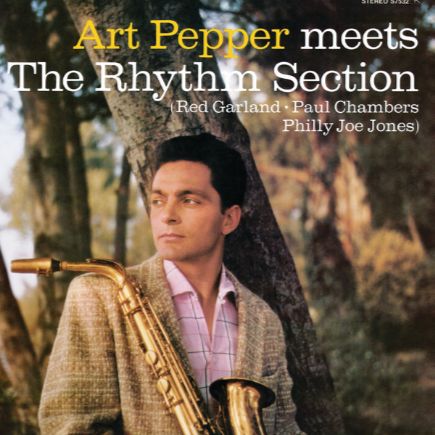Star Eyes: d’Hollywood au bebop
Écrite en 1942 par le compositeur Gene de Paul et le parolier Don Raye, Star Eyes fait sa première apparition dans le film I Dood It (Mademoiselle ma femme), troisième long métrage de Vincente Minnelli, sorti en 1943. Enregistrée à Hollywood entre le 10 et le 24 novembre 1942, la chanson est interprétée dans le film par l’orchestre de Jimmy Dorsey, avec les voix d’Helen O’Connell et Bob Eberly.
Mais c’est en 1951, avec l’enregistrement de Charlie Parker pour le label Verve, que Star Eyes entre dans une nouvelle ère: celle du jazz moderne. Parker transforme la ballade en un terrain d’exploration pour le langage du bebop, affirmant ainsi une tendance déjà amorcée dans les années 1940: celle de la réappropriation des chansons populaires par les musiciens de jazz
L’histoire de Star Eyes illustre cette transition majeure dans l’évolution du jazz: le passage de l’âge d’or des grandes formations à l’affirmation des petits groupes, centrés sur l’improvisation individuelle. Le thème principal, marqué par une ligne mélodique ascendante qui semble évoquer le scintillement des étoiles, offre un cadre idéal à la variation, à la réinvention, au jeu d’interprétation.
Art Pepper, la grâce du swing
Enregistrée à Los Angeles le 19 janvier 1957 pour l’album Art Pepper Meets The Rhythm Section, la version de Star Eyes illustre à merveille l’alchimie spontanée entre Art Pepper et la section rythmique de Miles Davis — Red Garland au piano, Paul Chambers à la contrebasse et Philly Joe Jones à la batterie. Cette rencontre, fruit du hasard et de l’instinct, est un équilibre parfait entre rigueur rythmique, inventivité mélodique et émotion à fleur de peau.
Sur Star Eyes, Art Pepper développe un phrasé fluide: son jeu, à la fois introspectif et lyrique, puise autant dans la légèreté du West Coast jazz que dans la densité émotionnelle du hard bop. L’alto devient ici un instrument de confession, transformant le thème romantique en une méditation musicale d’une rare intensité.
Red Garland accompagne avec une élégance feutrée, ponctuant le discours du soliste de touches harmoniques lumineuses et de réponses discrètes mais inspirées. Paul Chambers, solide et souple, maintient un flux régulier tout en dessinant des lignes mélodiques autonomes. Quant à Philly Joe Jones, il insuffle à l’ensemble une énergie souterraine, subtile et nerveuse, qui relie chaque respiration du quartet à un même mouvement intérieur.
Star Eyes: de Hollywood al bebop
Escrita en 1942 por el compositor Gene de Paul y el letrista Don Raye, Star Eyes apareció por primera vez en la película I Dood It, tercer largometraje de Vincente Minnelli, estrenado en 1943. Grabada en Hollywood entre el 10 y el 24 de noviembre de 1942, la canción fue interpretada en la película por la orquesta de Jimmy Dorsey, con las voces de Helen O’Connell y Bob Eberly.
Pero fue en 1951, con la grabación de Charlie Parker para el sello Verve, cuando Star Eyes entró en una nueva era: la del jazz moderno. Parker convirtió esta balada en un campo fértil para el lenguaje del bebop, consolidando una tendencia ya iniciada en los años cuarenta: la apropiación creativa de canciones populares por parte de los músicos de jazz.
La historia de Star Eyes ilustra una transición clave en la evolución del jazz: el paso de la edad de oro de las big bands a la afirmación de los pequeños conjuntos, enfocados en la improvisación individual. El tema principal, con su línea melódica ascendente que parece evocar el brillo de las estrellas, ofrece un marco ideal para la variación, la reinvención y el juego interpretativo.
Art Pepper, la gracia del swing
Grabada en Los Ángeles el 19 de enero de 1957 para el álbum Art Pepper Meets The Rhythm Section, la versión de Star Eyes ilustra de manera magistral la alquimia espontánea entre Art Pepper y la sección rítmica de Miles Davis —Red Garland al piano, Paul Chambers al contrabajo y Philly Joe Jones a la batería—. Este encuentro, fruto del azar y del instinto, alcanza un equilibrio perfecto entre rigor rítmico, inventiva melódica y emoción a flor de piel.
En Star Eyes, Art Pepper desarrolla un fraseo fluido: su interpretación, a la vez introspectiva y lírica, bebe tanto de la ligereza del jazz de la Costa Oeste como de la densidad emocional del hard bop. El saxo alto se convierte aquí en un instrumento de confesión, transformando el tema romántico en una meditación musical de intensidad poco común.
Red Garland acompaña con una elegancia discreta, salpicando el discurso del solista con toques armónicos luminosos y respuestas contenidas pero inspiradas. Paul Chambers, firme y flexible, mantiene un flujo constante mientras traza líneas melódicas independientes. Por su parte, Philly Joe Jones insufla al conjunto una energía subterránea, sutil y nerviosa, que conecta cada respiración del cuarteto con un mismo impulso interior.
Star Eyes: da Hollywood al bebop
Scritta nel 1942 dal compositore Gene de Paul e dal paroliere Don Raye, Star Eyes compare per la prima volta nel film I Dood It (Il signore in marsina), terzo lungometraggio diretto da Vincente Minnelli, uscito nel 1943. Registrata a Hollywood tra il 10 e il 24 novembre 1942, la canzone è interpretata nel film dall’orchestra di Jimmy Dorsey, con le voci di Helen O’Connell e Bob Eberly.
È però nel 1951, con l’incisione di Charlie Parker per l’etichetta Verve, che Star Eyes entra in una nuova fase: quella del jazz moderno. Parker trasforma la ballad in un terreno di esplorazione per il linguaggio del bebop, confermando una tendenza già emersa negli anni Quaranta: la rilettura creativa, da parte dei jazzisti, del repertorio popolare.
La storia di Star Eyes rappresenta una tappa cruciale nell’evoluzione del jazz: il passaggio dall’età d’oro delle grandi orchestre all’emergere dei piccoli ensemble, incentrati sull’improvvisazione individuale. Il tema principale, caratterizzato da una linea melodica ascendente che evoca il luccichio delle stelle, offre uno spazio ideale per la variazione, la reinvenzione e l’interpretazione personale.
Art Pepper, la grazia dello swing
Registrata a Los Angeles il 19 gennaio 1957 per l’album Art Pepper Meets The Rhythm Section, la versione di Star Eyes illustra perfettamente l’alchimia spontanea tra Art Pepper e la sezione ritmica di Miles Davis —Red Garland al pianoforte, Paul Chambers al contrabbasso e Philly Joe Jones alla batteria—. Questo incontro, frutto del caso e dell’istinto, rappresenta un equilibrio ideale tra rigore ritmico, inventiva melodica ed emozione palpabile.
In Star Eyes, Art Pepper sviluppa un fraseggio fluido: il suo linguaggio, insieme introspettivo e lirico, attinge tanto alla leggerezza del jazz della West Coast quanto alla densità emotiva dell’hard bop. L’alto diventa qui uno strumento di confessione, trasformando il tema romantico in una meditazione musicale di rara intensità.
Red Garland accompagna con un’eleganza soffusa, punteggiando il discorso del solista con tocchi armonici luminosi e risposte discrete ma ispirate. Paul Chambers, solido e flessibile, mantiene un flusso regolare disegnando al tempo stesso linee melodiche autonome. Philly Joe Jones, invece, infonde all’insieme un’energia sotterranea, sottile e nervosa, che lega ogni respiro del quartetto a un unico movimento interiore.
Star Eyes: from Hollywood to bebop
Written in 1942 by composer Gene de Paul and lyricist Don Raye, Star Eyes made its first appearance in the film I Dood It, Vincente Minnelli’s third feature, released in 1943. Recorded in Hollywood between November 10 and 24, 1942, the song was performed in the film by Jimmy Dorsey’s orchestra, featuring vocalists Helen O’Connell and Bob Eberly.
But it was in 1951, with Charlie Parker’s recording for the Verve label, that Star Eyes entered a new era: that of modern jazz. Parker transformed the ballad into fertile ground for the bebop language, reinforcing a trend already underway in the 1940s—the creative appropriation of popular songs by jazz musicians.
The story of Star Eyes reflects a key transition in the history of jazz: the shift from the golden age of big bands to the rise of small ensembles focused on individual improvisation. The main theme, shaped by an ascending melodic line that evokes the shimmer of starlight, provides an ideal framework for variation, reinvention, and interpretive freedom.
Art Pepper, the grace of swing
Recorded in Los Angeles on January 19, 1957, for the album Art Pepper Meets The Rhythm Section, the version of Star Eyes beautifully captures the spontaneous chemistry between Art Pepper and Miles Davis’s rhythm section —Red Garland on piano, Paul Chambers on bass, and Philly Joe Jones on drums. This encounter, born of chance and instinct, achieves a perfect balance between rhythmic precision, melodic inventiveness, and deeply felt emotion.
On Star Eyes, Art Pepper develops a fluid phrasing style: his playing, both introspective and lyrical, draws as much from the lightness of West Coast jazz as from the emotional depth of hard bop. The alto saxophone becomes here an instrument of confession, transforming the romantic theme into a musical meditation of uncommon intensity.
Red Garland accompanies with understated elegance, punctuating the soloist’s lines with luminous harmonic touches and subtle yet inspired responses. Paul Chambers, steady and supple, maintains a flowing pulse while sketching independent melodic lines. Philly Joe Jones, for his part, infuses the ensemble with a subterranean energy—subtle and tense—that connects each breath of the quartet to a shared inner motion.


